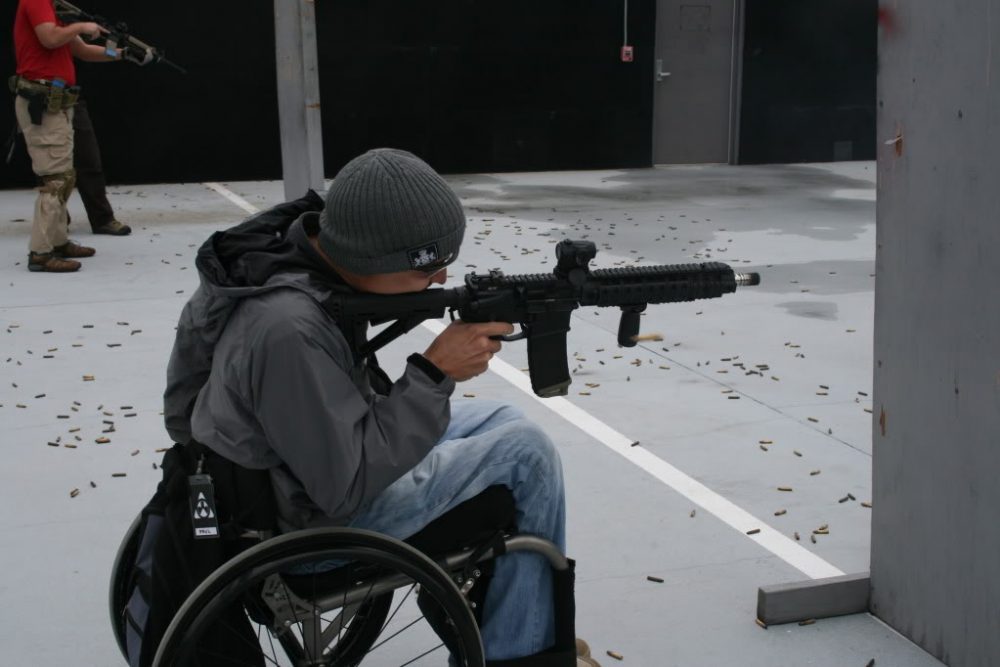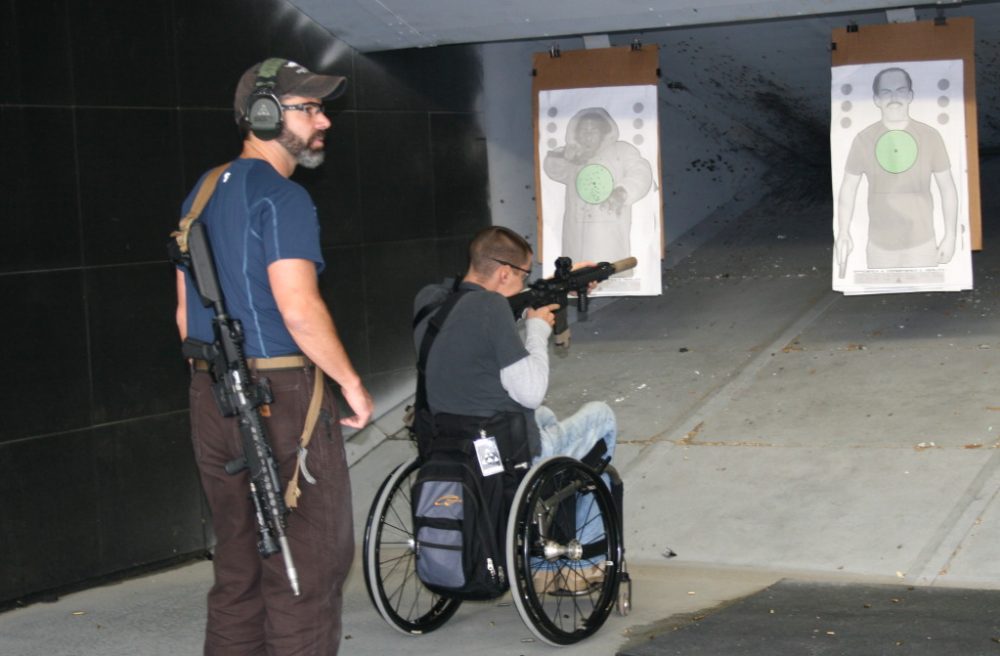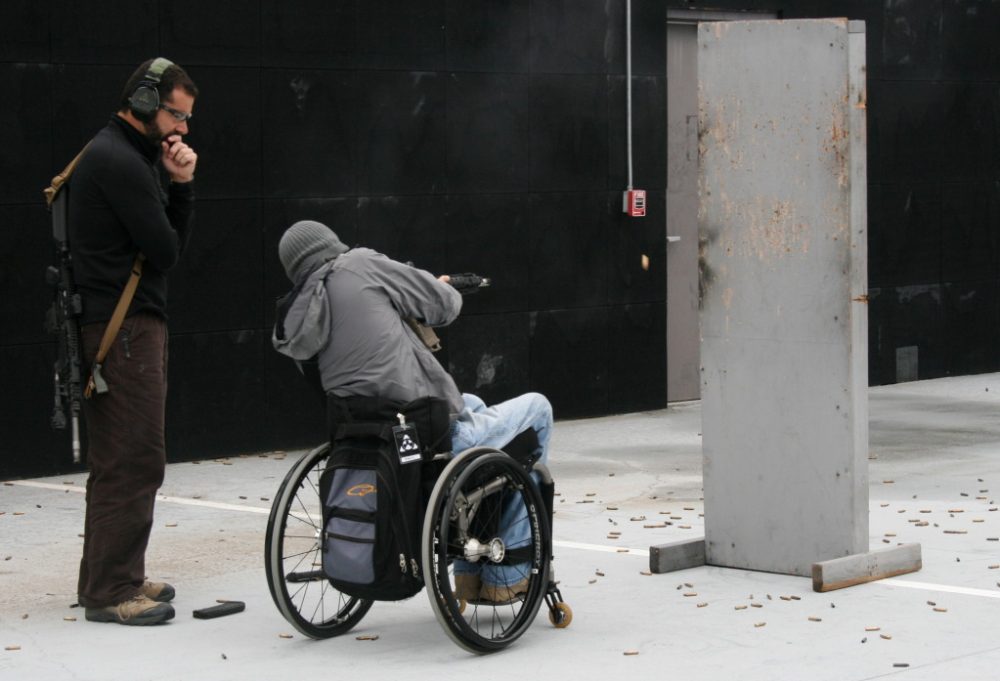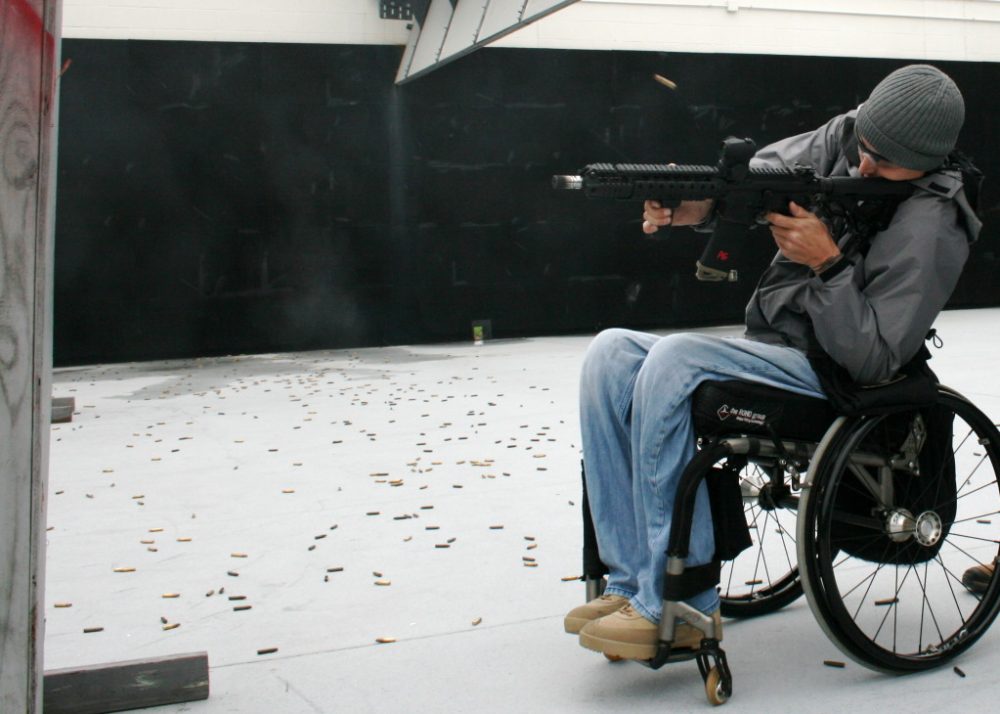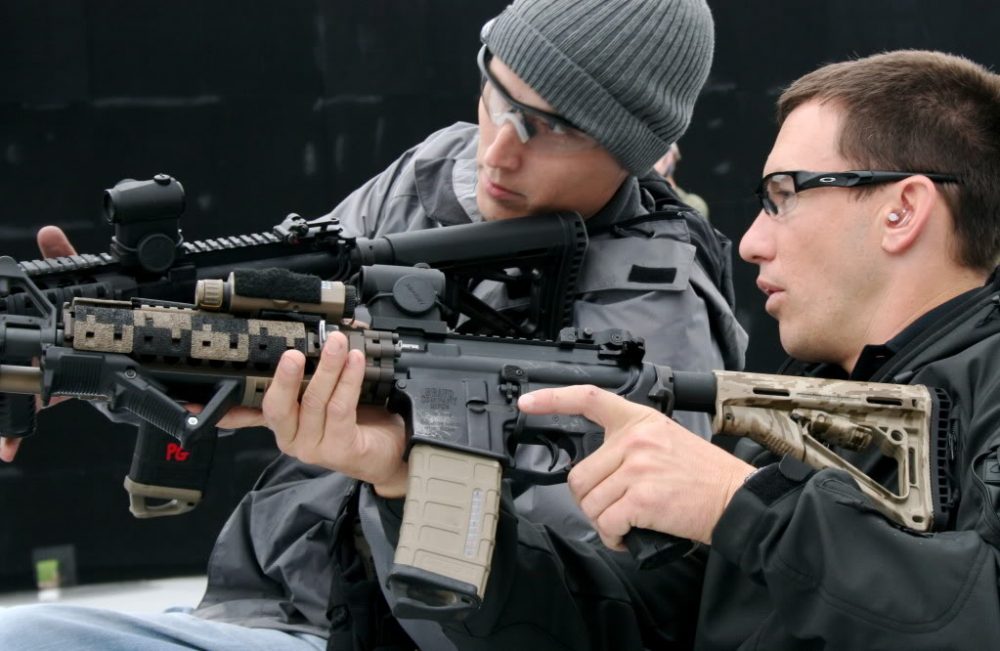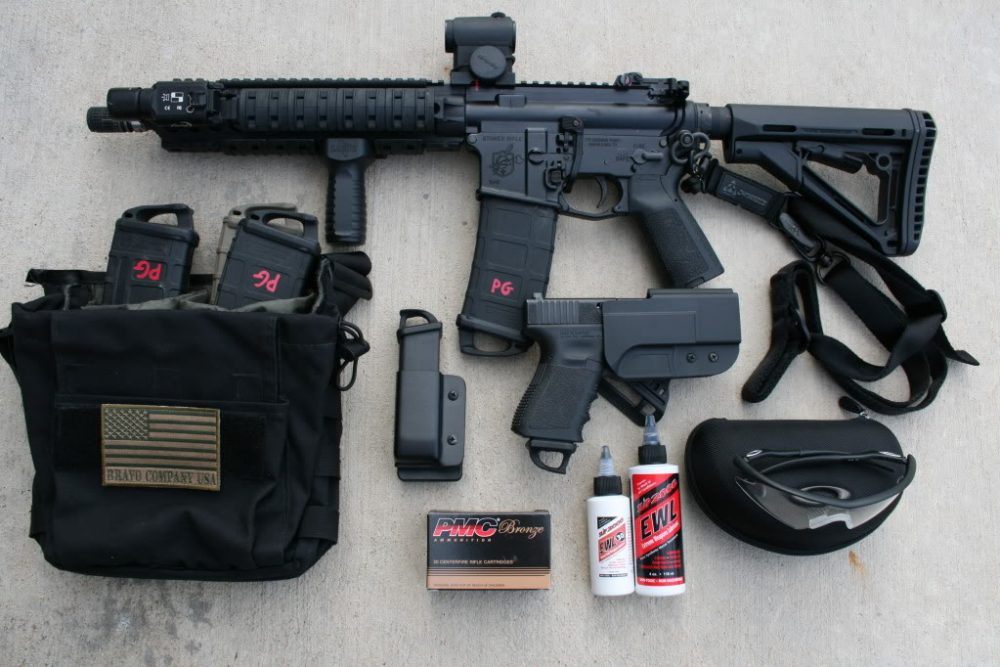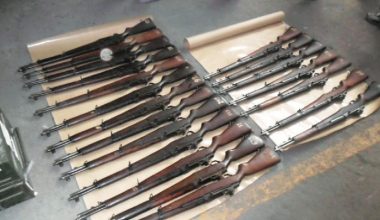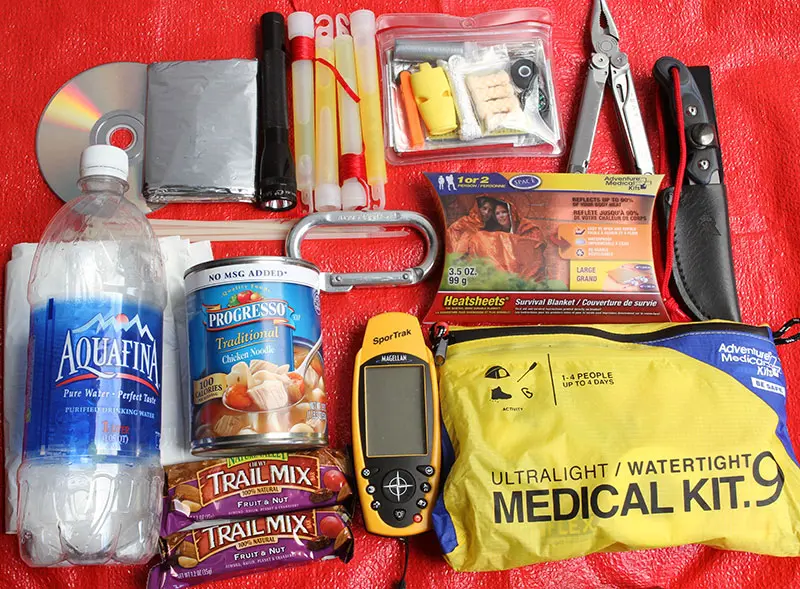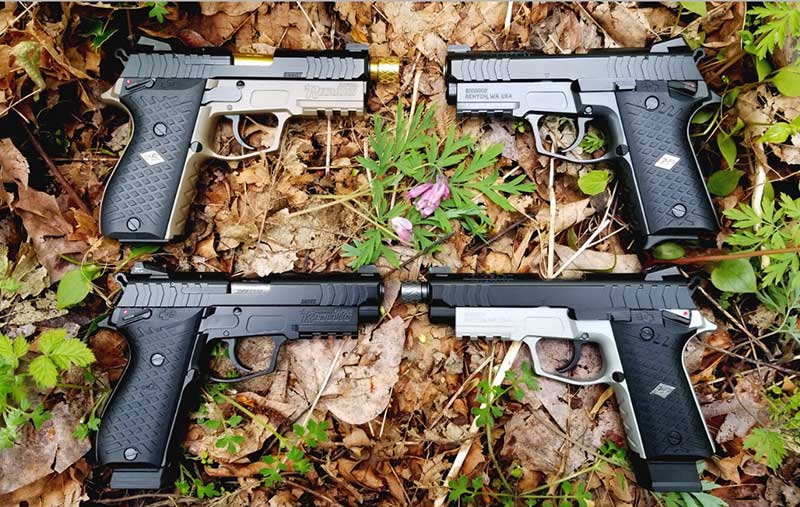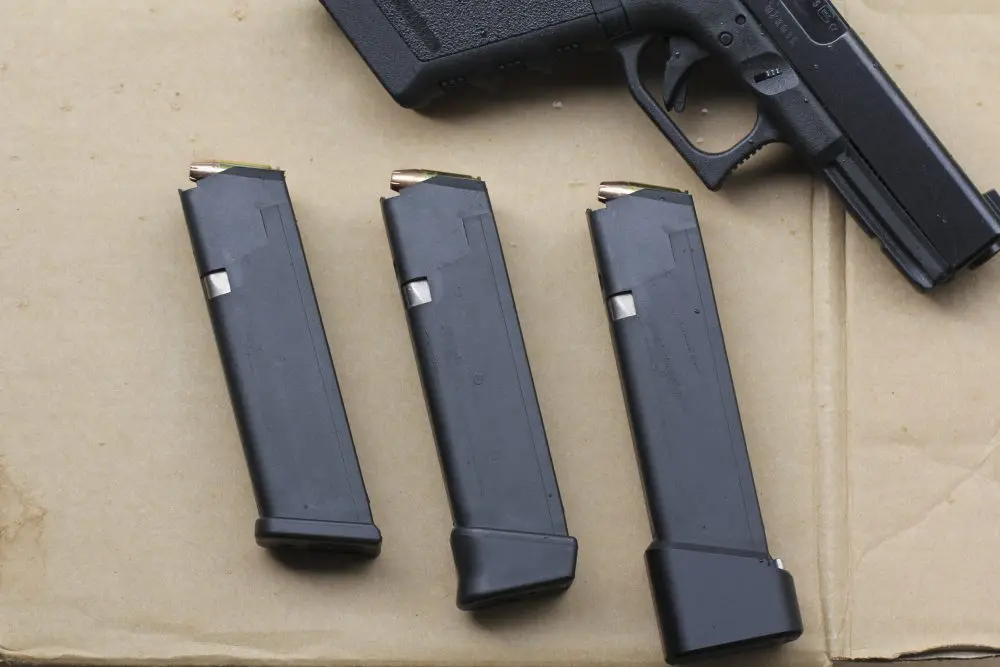Paul Gardner shoots from Urban Prone position for the first time.
My days of not shooting because I’m in a wheelchair are over. Recently Magpul Dynamics (the training arm of Magpul Industries) conducted their Dynamic Carbine 1 course in Houston, Texas. Chris Costa and Travis Haley were the course instructors and I was one of their students.
The course was hosted by Matt Brockmann of MAST Solutions and held at the Houston Community College Police Academy Gun Range, which is an outstanding state-of-the-art training facility consisting of shooting distances from 3 to 50 yards with a concrete surface and blast baffles overhead. It gets pretty loud with 15-plus students all blasting away at once with their carbines, especially when short barreled rifles like mine are fired with muzzle brakes, but overall it’s a great range to host classes at.
For me, it really is by far the best and most wheelchair-friendly outdoor range I’ve shot and trained at since I began doing this type of training several months ago (I’ve taken three carbine classes in three months now). I hope to continue training there in the future.
Table of Contents
TRAINING DAY 1
We met at the range’s classroom on Training Day 1 (TD1) at 0800 for a very in-depth safety brief and to take care of other general administrative business. Chris Costa and Travis Haley introduced themselves and gave us a rundown of how things would go over the next two days, as well as explaining Magpul Dynamics’ (MD) core principles of Reality, Efficiency and Consistency and exactly what each one means in relation to MD’s style of training.
The class consisted of 17 shooters from various walks of life. There were several law enforcement officers in our class, with the rest being a diverse crowd of civilians. Some were prior military, but most were not.
The carbines in use ranged from a couple of Colts, Noveskes, and LWRCs to DPMS and Rock River Arms. There were a few custom builds too, as well as one very sexy LaRue Stealth upper. The majority of the quality rifles like Colt, Noveske, and LWRC experienced few if any malfunctions.
Working right side of barricade with one arm.
We geared up and hit the range at around 0900. The high temperature on TD1 was around 70 degrees and very cloudy with a chance of rain, although we stayed pretty dry that day.
We kicked things off with zeroing our carbines. My 11.5-inch Bravo Company Manufacturing (BCM) SBR with Aimpoint Micro T-1 red dot sight was already zeroed, but I passed it off to Chris Costa so he could quickly confirm my 50-yard BZO from the prone position. That way I didn’t have to have them move up a table for me to bench my gun on just to confirm my zero. After everyone’s zero was dialed in, we began working on administrative, tactical and speed reloads.
Chris and Travis demonstrated each one before the students ran the drills. Simply put, both men are seriously skilled shooters! Not only is their rate of fire phenomenally fast, but it’s also extremely accurate as well, with the overwhelming majority of their shots landing in the high center chest of the targets.
At 1200 we broke for chow. When we returned at 1300 we spent the next hour back in the classroom for the Mindset lecture.
It was extremely informative, and I believe it’s vital to this type of class. Although we were shooting at paper targets, in reality those targets represent a bad guy that we might someday have to kill. I think it’s crucial for those of us who are receiving this type of training, and who might actually use what we learn to defend ourselves or our loved ones from some bad guy, to understand the psychological effects of actually engaging and killing another human being. It’s vital to know how the body, mind, eyes and basic senses react to such traumatic and violent events as they’re taking place.
During this portion of the class, for the very first time in front of a group of people, I told the story of how I was wounded in Iraq. I was a bit nervous at first, but then I just acted as if I was bullshitting with my fellow Marines and was fine for the next eight or so minutes as I spoke to the class.
Although I probably dropped well over 100 f-bombs in my profanity-laced story, I knew that I had gotten my point across very effectively. This was evidenced by many of the students telling me throughout the rest of our training just how much it meant to them to hear my story, and that it really sunk in how important basic weapon manipulation skills are, and why Travis and Chris were teaching us to do things the way that they were.
To put it bluntly, the mistakes I made in combat, which led to my being shot in the chest (just under the left armpit) and paralyzed from the waist down, were primarily the result of either training scars or simply not being shown how to perform some vital weapon manipulation techniques. (See AL TARMIYAH FIREFIGHT! Lessons Learned The Hard Way, March 2009 S.W.A.T.)
After the Mindset lecture, we headed back out to the range. We worked on the Dynamic Kneeling and Prone positions. When demonstrating the Dynamic Prone position, the Magpul Dynamics duo dropped their bodies straight down fast and hard on the deck with boatloads of decisiveness and aggression. They gave 100% as they demonstrated the techniques we were about to perform, and we could all see the pain in their eyes and on their faces as their bodies slammed down on the concrete at lightning speed. I firmly believe that watching Travis and Chris put themselves through obvious physical pain motivated the hell out of the students and encouraged them to do the same.
Final shooting and moving drill with Knight’s Armament suppressor mounted.
Some of the students immediately got the hang of quickly getting into the Kneeling and Prone positions, while others took a little longer to adjust to such rapid movements. In several cases, the student’s age no doubt played a role in the speed with which he transitioned from Standing to Prone. Lack of experience was also a factor, which is to be expected in a basic carbine course.
Some students would actually get down on the ground and into the Prone position quickly enough, but were dropping very easy shots because they were holding their carbine up off the deck. Travis saw this and asked the class, “Is it okay to rest the magazine on the deck?” One student said, “No, doing that can cause feeding problems.” Travis responded, “Not with the PMAG it won’t.”
He explained that it’s perfectly fine to rest the magazine on the deck and use it as a monopod to help stabilize the gun. He then demonstrated this for us, once again slamming his body down on the concrete and resting his carbine’s magazine on the deck as he fired tremendously fast, connecting with the high center chest as usual. The point was taken, and techniques among several of the students changed.
I obviously cannot get into the Kneeling or Prone positions since I’m confined to a chair, so instead I leaned forward and rested my left elbow on my left thigh for “Kneeling.”
As for “Prone,” Chris came up with the idea of me substituting that position with a 90-degree turning drill, so that I could get some more diverse training out of it rather than just leaning forward and using my knee for support again.
Travis, Chris and I continued to come up with very unique, interesting and downright fun ways for me to take on the many challenges in this class. I could tell they had put a lot of thought into exactly how to include me in each and every drill, whether that meant trying the actual position/technique, or if it wouldn’t work for me, substituting it for something else so that I could get in some trigger time anyway.
The main point here is that they didn’t baby me or treat me like some stereotypical “pussy ass” disabled Veteran at all, the way that TV shows and movies always seem to portray us. They treated me like the Marine Infantryman that I still consider myself to be, and ran me harder than anyone’s run me before—and I loved every minute of it!
Shooting barricade drill under watchful eyes of Chris Costa.
TRAINING DAY 2
The weather on TD2 started off nasty. As I pulled up in the parking lot, it was raining quite a bit. It was 65 degrees in the morning, with a high of 74 later in the day, although I personally don’t think it ever reached that high. I comfortably wore a beanie on my head and my thin waterproof jacket for the majority of the day.
We kicked off TD2 by running the Balance of Speed and Accuracy (BSA) drill. Some students, myself included, were told to fire three shots instead of the usual two, in order to try and reach our individual failure points.
Everyone is unique and has a different skill level and point of failure. Travis and Chris are great at identifying each student’s individual skill sets. Students in these basic courses are generally good at a few things and not so good at others.
The Magpul instructors really push you hard on everything you do, but constantly tweak their training methods during the class for each and every student. They keep a very loose grip on the leash and give you more freedom and leeway when you excel at something, but pull it back in and give you much more TLC when you’re not performing at the level you could be reaching.
I dropped 16 shots on the BSA drill, which really frustrated me. I was doing the 90-degree turning drill at the 50-yard line to substitute for the Standing-to-Prone course of fire. I would face right, hear the shot timer go “beep,” turn my chair to the left as fast as possible to square up to the target, lock up my brakes, raise my rifle and quickly fire off three shots at the target downrange within the four allotted seconds we had to complete the drill (which was more than enough time). I’m going to work on that technique some more and strive to get much better at it.
After we ran the BSA drill, the rest of the students learned how to do the Supine position and then practiced doing it dry, followed by running it live. This would be the only course of fire during the entire Dynamic Carbine 1 class that I would not participate in, in some form or another. Chris asked me if I wanted to give Supine a go, but I had already tried that position in my first carbine class several months ago and it just didn’t work out for me.
I now really regret not trying it, because now I think that I could’ve done my own personal version of a Supine position. By simulating falling over backwards in my wheelchair and, instead of trying to lean forward and fire (which is what I had tried previously and found impossible), I think I could’ve just rolled my upper body to the right or left and done an adaptation of Urban Prone. I’ll definitely be trying that one at the range very soon.
When it was time to run the Urban Prone position, the range safety officer brought out a mat for me to lie on. Chris Costa set it up and then grabbed my chair (with me in it of course) and slowly tipped it over to the right side. Success! I was in the Urban Prone for the first time ever, and it rocked! Chris knelt behind me and helped stabilize me to keep my body in the correct position, as it was hard doing it for the first time.
Working left side of barricade.
With more time I definitely could’ve worked on the technique without him having to stay behind me like that, but we were being overly cautious in that position because my body is so damn fragile and I didn’t want to injure myself.
I literally snapped my left femur with my bare hands while stretching and working on my range of motion exercises in the VA Hospital two years ago, so obviously my body can only handle so much physical punishment nowadays. I didn’t want to break or damage something from overdoing it in a position I’d never done before, because I probably wouldn’t have realized it until I got back home that night, since I can’t feel anything from the waist down. But I definitely want to get into the Urban Prone again, as it was a blast!
I simply can’t explain how great it feels when I’m doing something like that with the rest of the class. It makes me feel like I’m not disabled and not being singled out, and I’m really glad that I tried it and succeeded!
After running my gun in Urban Prone on the right side, Chris tilted me and my chair back upright and then tipped me (slowly) over to my left side, where I shot off another mag at some crazy-looking white dude who was giving me the evil eye (paper targets, of course, just in case some hippie reading this thinks we were removing real oxygen thieves during the class). My body definitely preferred lying on the left side in the Urban Prone as opposed to the right, and I functioned much better in this position.
Next we ran some malfunction drills, starting with the good ol’ tap-rack-bang. I’ve been doing this since I was in the Marine Corps and, as we all know, it’s not exactly rocket science. But I still really like going over it often enough so that I never hesitate to perform immediate action when the weapon system goes “click” instead of “bang.”
We also worked on clearing double feeds. I have been running Magpul’s new BAD (Battery Assist Device) Lever on several of my lowers for the past month now, and man does it make life easier when clearing a double feed, or any other time you need to lock the bolt to the rear or send that bolt home in a hurry. I really like it, but still need a lot more time with it to reach the ideal level of efficiency that the BAD Lever makes possible.
After that, the barricades were pulled out, and Chris and Travis showed us the best way to navigate our bodies and carbines around them in order not to expose too much of ourselves to possible incoming enemy fire.
I can’t say enough about how great their live-fire demos are and how much we all learned from watching them run their guns like madmen! At one point Chris Costa ran the Knight’s Armament Corporation (KAC) .308-caliber SR-25 Battle Rifle while working the barricade. It was friggin’ awesome watching him shoot that beast, and with a .308 version of the outstanding KAC Triple Tap muzzle brake mounted on its muzzle, Chris was able to control the hell out of it as he blasted away at the threats downrange.
When I first approached the barricade, I locked my chair up several feet behind it, leaned out to the right and shot one-armed while holding onto my chair with my left hand. Travis witnessed me doing this and came over to work with me on my technique. Both Travis and Chris pushed me to do it the right way, regardless of the fact that I am in a wheelchair.
Of course there are times when I simply cannot physically do something (e.g., Dynamic Prone), so I have to substitute something else. Thus, Travis had me lean over to the right and use both hands on the gun, which allowed me to have greater accuracy and fire much faster.
But then Travis took advantage of my being able to one-arm the gun (something I have practiced) by having me fire five shots at the target using both hands on the gun. Then I leaned out a bit more while one-arming it and hit a target that was farther to the left, which I could only see by leaning out farther to my right. After I fired my ten rounds on the right side of the barricade, I’d transition to my Reaction side (left) shoulder and run the same drill from that side, then I’d switch back to my Weapon side (right) shoulder, sling my weapon and roll away from the barricade.
The other students would line up behind each barricade and perform different positions at each one: Standing, Kneeling, both Standing and Kneeling, and then Urban Prone on both sides of their bodies. Everyone really enjoyed shooting around and under barricades. It’s something that a lot of guys don’t have access to at their local ranges.
Getting some great instruction from Travis Haley on navigating the barricade.
After lunch, we trained with just our pistols for about an hour. We started off slowly in the High Compressed Ready and then extended our secondary firearms outward, touched the trigger, pressed the trigger, really concentrated on trigger control and reset, and then did it over again while trying to maintain a tight group. Speed was obviously not the goal here.
Travis and Chris showed us how to maintain a proper grip on our handguns and just how much a shooter’s grip on the gun helps to either control the recoil or have the recoil control you if you’re not doing it properly. We then worked on our draws from the holster. We ran all these drills with our secondary weapons from three to seven yards.
After we practiced our draws from the holster, we slung our carbines back on and worked on primary-to-secondary transitions. Once they were confident we could handle it well and safely enough, Chris and Travis told us from that point on we could transition to our secondary weapons whenever our primaries ran dry if we wanted to.
At around 1500 that afternoon we started shooting on the move. In order to prevent the range from getting too crowded, the students split up into two groups and took turns listening to Costa shout out the commands “Forward, rear, right, left.”
It was funny watching dudes start to move to the right whenever “Left” or “Forward” was called out. I noticed that some students had a tendency to over-think everything whenever moving was incorporated into shooting for the first time, especially when they were all on the line together—myself included.
I sat back and watched the two groups of students run the movement drill, and then Chris and I went up to the firing line and I ran the drill by myself as the rest of the students were reloading their mags and hydrating back behind the 50-yard line.
Chris would call out a direction, I’d turn my chair (if need be) and push as fast as my tired body could manage for several feet, then quickly lock my brakes up and raise my carbine to fire off five to ten rounds at the target.
On the last one that Chris called out, he had me fire at multiple targets. Once again Chris pushed me hard and treated me like a Wounded Warrior instead of a disabled veteran.
The last course of fire we ran was the whole firing line (again split into two groups) shooting when threats were called out while slowly walking forward and backward. I participated in this with everyone else.
As I mentioned earlier, when moving and shooting are incorporated with each other, less experienced students have some issues doing two combined tasks. For the first several attempts, I had problems staying on line with everyone else.
I wasn’t pushing my chair hard enough in between each threat that was called out, and it was hard to time the one good push I could get with everyone else’s walking pace. Costa soon approached me (he was actually behind me the entire time for safety reasons) and basically told me that I needed to get my shit together and really focus on staying on line with everyone else (in a polite way, of course).
“Roger that!”
Once he made me aware of my errors, I was able to correct them and made sure to look to my right as I moved. I was all the way on the left flank during this drill. When “Threat” was called as we were moving, I might only be able to get off two shots instead of three or four, because I had to ensure that I didn’t start lagging behind the line as my chair slowed down without me pushing it. I realized later that night that my tires were really low, which definitely affected how smoothly my chair was rolling on the moving and shooting drills.
CLIMBING THE LADDER
That completed our Magpul Dynamic Carbine 1 course. Everyone was really tired, yet we were all happy and in great spirits, each feeling a great sense of accomplishment. I was amped up for the duration of the night, long after I drove back home. It’s a great feeling for me when I attend and complete a carbine class. I always feel like a Marine Infantryman again, like I’m on top of the world and truly unstoppable. It’s an awesome feeling that is hard to come by these days, and doing this kind of stuff is the only thing I have found to get that high back that I experienced so long ago.
I think everyone reading this would benefit greatly from taking a Magpul Dynamics class, even if you’re already an experienced shooter. Travis and Chris are the real deal. They are also extremely modest regarding their exploits, achievements, experiences and time behind the gun in actual combat. If you attend one of their courses, listen to and take in everything they say, plus take notes when and where you can.
I learned a lot about my gear, my gun, my body and myself in this class. I am simply amazed at how much I learned and accomplished over the course of a weekend. However, I still think I could’ve performed much better and will strive to improve. I want to continue to climb that “ladder of excellence” that Travis Haley always talks about. I’ve come a tremendously long way in the past year since I got back into shooting—but that ladder’s really high.
[Many thanks to Chris Costa and Travis Haley for taking this Wounded Warrior on as a student and pushing me so hard. I’m proud to call them brothers-in-arms. Thanks to Matt Brockmann of MAST Solutions for finding the HCC Police Academy Gun Range at the last minute and for hosting this course. Finally, I want to thank my good friend and fellow former 0311 Marine, Jeff Carpenter, who helped me get started on the right path with equipment and training.]
SOURCES:
Magpul Dynamics
Dept. S.W.A.T.
P.O. Box 17697
Longmont, CO 80308-0697
(877) 4MAGPUL
www.magpuldynamics.com
Aimpoint Inc.
Dept. S.W.A.T.
14103 Mariah Court
Chantilly, VA 20151-2113
(877) 246-7646
www.aimpoint.com
Blade-Tech Industries
Dept. S.W.A.T.
2506 104th Street Court South
Building H
Lakewood, WA 98499
(877) 331-5793
www.blade-tech.com
Bravo Company USA, Inc.
Dept. S.W.A.T.
P.O. Box 341
Hartland, WI 53029
(877) 272-8626
www.bravocompanyusa.com
Knight’s Armament Company
Dept. S.W.A.T.
701 Colombia Blvd.
Titusville, FL 32780
(321) 607-9900
www.knightarmco.com
LaRue Tactical
Dept. S.W.A.T.
850 County Road 177
Leander, Texas 78641
(512) 259-1585
www.LaRueTactical.com
Magpul Industries Corp.
Dept. S.W.A.T.
400 Young Court
Erie, CO 80516-8440
(877) 462-4785
www.magpul.com
PMC Ammunition
Dept. S.W.A.T.
P.O. Box 940878
Houston, TX 77094-7878
(281) 759-9020
www.pmcammo.com
The gear Gardner selected was a good choice for the class.
GEAR TO SWEAR BY, NOT AT
I ran my outstanding Bravo Company Manufacturing (BCM) 11.5-inch SBR on my registered Knight’s Armament Company (KAC) SR-15 lower in the following configuration:
- BCM bolt carrier group and BCM Gunfighter charging handle (Mod 04)
- KAC Triple Tap muzzle brake
- LaRue Tactical FUG (Forward Universal Grip))
- KAC URX II Mid-Length free-floating rail with integral flip front sight
- Aimpoint Micro T-1 red dot sight on a LaRue Tactical high mount
- Magpul CTR stock with extended butt-pad
- Magpul MIAD pistol grip
- Magpul BAD Lever
- Magpul MS2 single-point sling
The gun ran great for just under the 1,000 rounds I fired, and it had zero issues. I can’t possibly say enough great things about Bravo Company Manufacturing. Their guns are meant to be shot a lot, and they can take everything you throw at them. I haven’t cleaned mine for several thousand rounds and it’s still going strong without any issues whatsoever, as long as I squirt a little Slip 2000 Extreme Weapon Slip 2000 Extreme Weapon Lubricant (EWL) in there in between my high round count shooting sessions.
I also attached Chris Costa’s Knight’s Armament M4QD sound suppressor for the last course of fire (shooting and moving). It made my SBR very muzzle heavy, but it did tame and suppress the muzzle blast and nastiness associated with firing an SBR in a semi-enclosed environment. Of course I now really want to buy one.
The KAC suppressor also darkened my Triple Tap Brake a little, which was nice, although I don’t really care what color it is because it simply works so well in keeping my recoil down to a controllable minimum, without being nearly as obnoxious as the other brakes out there. The Triple Tap Brake and an SBR make a great combination.
My secondary weapon was a Glock 19 in a Blade-Tech holster, worn in a crossdraw position at a 45-degree angle on my left hip, just to the left of my belt buckle. This position works well for me, even though it’s a bit slower on the draw because I consciously have to avoid sweeping my left femoral artery, as well as anyone standing to my left, when drawing my Glock from the holster. I accomplish this by drawing the pistol out of the holster, rolling it up to my chest into the High Compressed Ready and then punching out toward the target.
When I first began using this crossdraw technique about ten months ago, my draw was extremely slow and very robotic looking, as I consciously performed each step. But now, after doing it hundreds of times and firing a couple thousand rounds, I’m able to draw my Glock 19 up to the High Compressed Ready, punch out and fire all in one continuous, fluid motion.
Although theoretically I should always have been the last one to draw my secondary, since there’s more going on with me and I also have to drop my carbine to the right of my wheelchair to get it completely out of the way of my drawstroke, very rarely was I actually the last one to draw and fire when transitioning to my sidearm, which made me feel pretty good.
I ran about 30 pre-loaded PMAGs and, as usual, they functioned great. It saved me a lot of time during breaks because I didn’t have to reload any of my magazines, which is why I had the time to take so many notes and was able to write this article. I also have a hard time trusting my life to magazines other than PMAGs and good quality GI mags with Magpul no-tilt followers in them. There really is no reason to use anything else, in my honest opinion.
The ammo I used for my carbine was PMC Bronze 55-gr. .223 caliber FMJ. I have been using this ammo for all my range trips, training sessions and carbine courses, and it always performs well. I’ve yet to have any problems with it whatsoever and will continue to run it through my carbines. I also used PMC 115-gr. 9mm Luger FMJ for this class. The 9mm PMC ran great as well, with zero malfunctions. I wore two Blade-Tech mag pouches on my right hip, in between the one and two o’clock positions on my belt.
A Sneaky Bag held my four primary magazines. I’d used it in two previous classes, but after my most recent one I decided to “butcher” it in order to make it work better for me in a carbine course. After my scissor work on the Sneaky Bag, my PMAGs stick up out of it and I can index them very rapidly in a wide variety of positions. It works great for me and even functions as a small dump bag because it has a separate pouch. I’m still looking for that perfect man-purse that comes directly from the manufacturer already suiting my every need, without me having to cut several square feet of fabric off it in order to make it perform to my ridiculously high standards.


